
Gravy is a sauce generally made from the juices of meats and vegetables that run naturally during cooking and often thickened with corn starch or other thickeners for added texture. The gravy may be further coloured and flavoured with gravy salt or gravy browning or bouillon cubes. Powders can be used as a substitute for natural meat or vegetable extracts. Canned and instant gravies are also available. Gravy is commonly served with roasts, meatloaf, rice, noodles, fries (chips), mashed potatoes, or biscuits.

Offal, also called variety meats, pluck or organ meats, is the internal organs of a butchered animal. The word does not refer to a particular list of edible organs, and these lists of organs vary with culture and region, but usually exclude skeletal muscle. Offal may also refer to the by-products of milled grains, such as corn or wheat.

Schnitzel is a thin slice of meat. The meat is usually thinned by pounding with a meat tenderizer. Most commonly, the meat is breaded before frying. Breaded schnitzel is popular in many countries and is made using veal, pork, chicken, mutton, beef, or turkey. Schnitzel originated as wiener schnitzel and is very similar to other breaded meat dishes.

A frikandel is a traditional snack originating from the Netherlands, a sort of minced-meat sausage, of which the modern version was developed after World War II. The history of this snack in the Spanish Netherlands goes back to the 17th century.
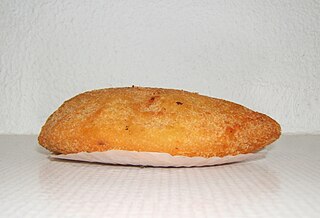
A rissole is "a ball or flattened cake of chopped meat, fish, or vegetables mixed with herbs or spices, then coated in breadcrumbs and fried."
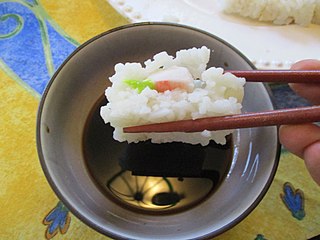
A dip or dip sauce is a common condiment for many types of food. Dips are used to add flavor or texture to a food, such as pita bread, dumplings, crackers, chopped raw vegetables, fruits, seafood, cubed pieces of meat and cheese, potato chips, tortilla chips, falafel, and sometimes even whole sandwiches in the case of jus. Unlike other sauces, instead of applying the sauce to the food, the food is typically placed or dipped into the sauce.

Filipino cuisine is composed of the cuisines of more than a hundred distinct ethnolinguistic groups found throughout the Philippine archipelago. A majority of mainstream Filipino dishes that compose Filipino cuisine are from the food traditions of various ethnolinguistic groups and tribes of the archipelago, including the Ilocano, Pangasinan, Kapampangan, Tagalog, Bicolano, Visayan, Chavacano, and Maranao ethnolinguistic groups. The dishes associated with these groups evolved over the centuries from a largely indigenous base shared with maritime Southeast Asia with varied influences from Chinese, Spanish, and American cuisines, in line with the major waves of influence that had enriched the cultures of the archipelago, and adapted using indigenous ingredients to meet local preferences.

Sisig is a Filipino dish made from pork jowl and ears (maskara), pork belly, and chicken liver, which is usually seasoned with calamansi, onions, and chili peppers. It originates from the Pampanga region in Luzon.

Rice vermicelli is a thin form of noodle. It is sometimes referred to as "rice noodles" or "rice sticks", but should not be confused with cellophane noodles, a different Asian type of vermicelli made from mung bean starch or rice starch rather than rice grains themselves.

Picadillo is a traditional dish in many Latin American countries including Mexico and Cuba, as well as the Philippines. It is made with ground meat, tomatoes, and also raisins, olives, and other ingredients that vary by region. The name comes from the Spanish word picar, meaning "to mince".

The completo is a hot dog variation eaten in Chile, usually served with ingredients such as chopped tomatoes, avocados, mayonnaise, sauerkraut, salsa Americana, ají pepper and green sauce. It can be twice the size of an American hot dog.

Most traditional foods in Guatemalan cuisine are based on Maya cuisine, with Spanish influence, and prominently feature corn, chilies and beans as key ingredients. Guatemala is famously home to the Hass avocado.

Many cuisines feature eggplant salads and appetizers.

A meatball is ground meat (mince) rolled into a ball, sometimes along with other ingredients, such as bread crumbs, minced onion, eggs, butter, and seasoning. Meatballs are cooked by frying, baking, steaming, or braising in sauce. There are many types of meatballs using different types of meats and spices. The term is sometimes extended to meatless versions based on legumes, vegetables, mushrooms, fish or other seafood.

Lumpia are various types of spring rolls from China, Indonesia, and the Philippines. Lumpias are made of thin paper-like or crepe-like pastry skin called "lumpia wrapper" enveloping savory or sweet fillings. It is often served as an appetizer or snack, and might be served deep-fried or fresh (unfried). Lumpia are Indonesian and Filipino adaptations of the Fujianese rùnbǐng and Teochew popiah, usually consumed during Qingming Festival.

Nilaga is a traditional meat stew or soup from the Philippines, made with boiled beef or pork mixed with various vegetables. It is typically eaten with white rice and is served with soy sauce, patis, labuyo chilis, and calamansi on the side.
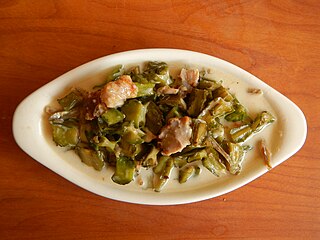
Gising-gising, also known as ginataang sigarilyas, is a spicy Filipino vegetable soup or stew originating from the province of Nueva Ecija, and was later introduced by Novo Ecijanos to Pampanga province. It is traditionally made with chopped winged beans, and coconut milk spiced with labuyo chili, garlic, onions, and bagoong alamang. The name literally means "wake up, wake up". It can be eaten alone, on top of rice, or as a side dish to grilled meat dishes. It is a type of ginataan.

Okoy or ukoy, are Filipino crispy deep-fried fritters made with glutinous rice batter, unshelled small shrimp, and various vegetables, including calabaza, sweet potato, cassava, mung bean sprouts, scallions and julienned carrots, onions, and green papaya. They are traditionally served with vinegar-based dipping sauces. They are eaten on their own or with white rice. They are popular for breakfast, snacks, or appetizers. Okoy are sometimes dyed bright orange with achuete seeds.
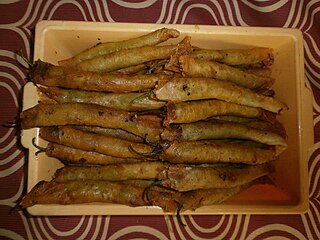
Dinamita is a deep-fried Filipino snack consisting of stuffed siling haba wrapped in a thin egg crêpe. The stuffing is usually giniling, cheese, or a combination of both but it can also be adapted to use a wide variety of ingredients, including tocino, ham, bacon, tuna, and shredded chicken. Dinamita is also known as dynamite lumpia, among other names. It is a type of lumpia and it is commonly eaten as an appetizer or as a companion to beer.
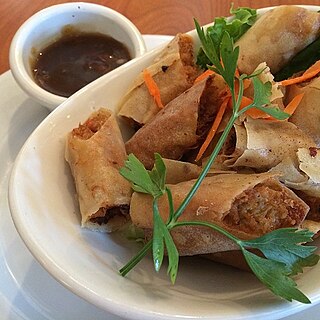
Lumpiang Shanghai is a Filipino deep-fried appetizer consisting of a mixture of giniling with vegetables like carrots, chopped scallions or red onions and garlic, wrapped in a thin egg crêpe. Lumpiang Shanghai is regarded as the most basic type of lumpia in Filipino cuisine, and it is usually smaller and thinner than other lumpia variants.





















